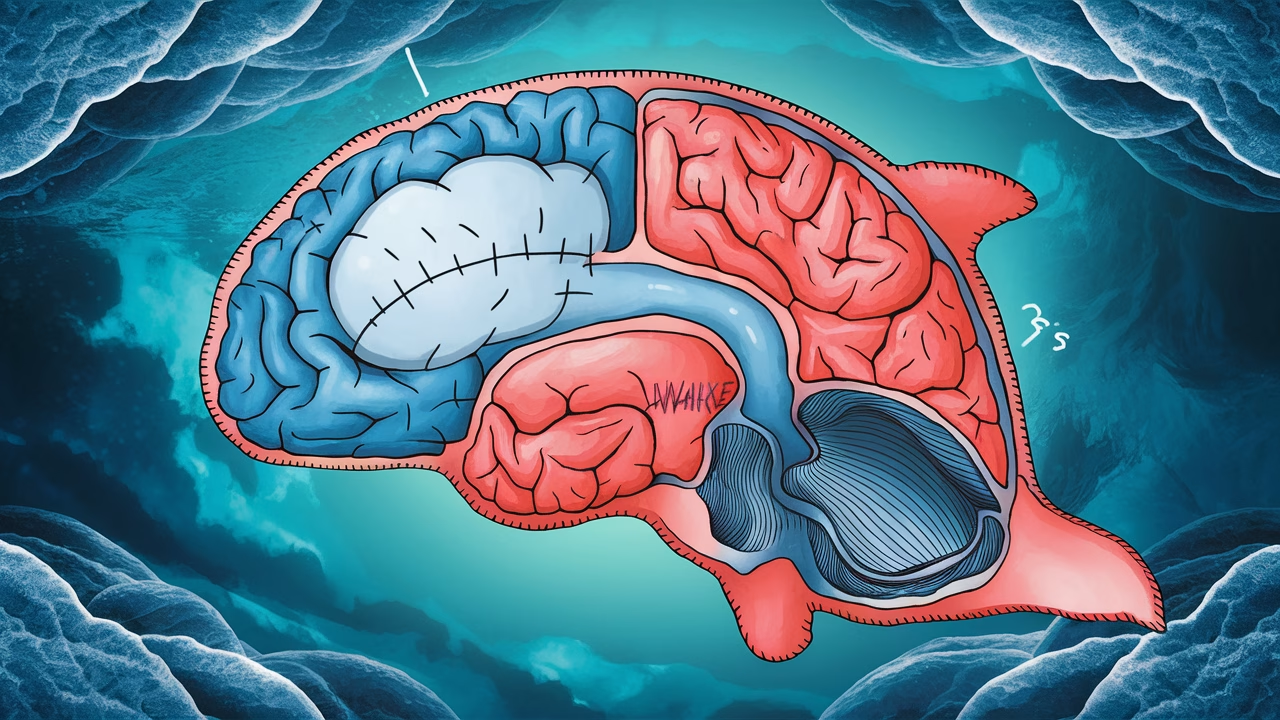Why do dolphins sleep with one brain hemisphere awake?
Dolphins sleep using a method called unihemispheric slow-wave sleep, allowing one half of the brain to rest while the other remains awake. This amazing adaptation lets them stay conscious enough to breathe, swim, and stay alert for predators or other threats in their aquatic environment. It’s nature’s answer to the challenge of sleeping underwater without drowning or becoming oblivious to danger.
TL;DR – How Dolphins Sleep Without Losing Consciousness
- Unihemispheric sleep enables one brain hemisphere to stay alert while the other rests.
- Dolphins must regularly surface to consciously breathe, which wouldn’t be possible if both hemispheres were asleep simultaneously.
- This unique sleep strategy also helps them stay vigilant against predators.
- They alternate hemispheres—one side sleeps while the other stays involved in swimming and scanning the surroundings.
- The mechanism is deeply tied to dolphin brain activity during sleep studied in marine biology.
Understanding Dolphin Sleep Patterns in Marine Biology
Ever tried to sleep while staying alert for danger? For dolphins, that’s their everyday reality. When we think of sleep, we often imagine a complete shutdown—eyes closed, muscles relaxed, the mind drifting… But for dolphins, it’s far more complex.
Because dolphins are voluntary breathers, they must remain conscious to draw each breath. Falling into full sleep like land mammals would mean risking death by drowning. Evolution, as it so often does, found a remarkable workaround: unihemispheric sleep.
What is Unihemispheric Sleep?
Unihemispheric sleep is a rare phenomenon where only one brain hemisphere enters a sleep state while the other remains active. This unique dolphin sleep adaptation allows them to:
- Maintain bodily movement and swimming
- Control breathing consciously
- Remain partially alert to environmental threats
You might be surprised to learn that dolphins aren’t alone in this practice. Several bird species and other aquatic mammals (like some whales and seals) demonstrate similar behaviors—but few do it with the grace and effectiveness that dolphins display in their natural habitat.
How Do Dolphins Alternate Brain Hemispheres During Sleep?
Think of a lighthouse—its beam sweeping across the dark ocean. That’s similar to how a dolphin’s alertness works during sleep. One brain hemisphere remains in a light-state awareness, flashing its beam of vigilance while the other hemisphere dives into rest.
Marine biology research using EEG monitoring has enabled scientists to observe this fascinating brain behavior. Researchers noticed slow-wave activity indicative of deep sleep in one hemisphere while the other showed signs of attentiveness—sometimes even with the eye opposite the awake brain hemisphere remaining open.
This alternating pattern continues throughout their sleep patterns, with each hemisphere typically getting around 4 hours of rest in a 24-hour window, totaling about 8 hours of rest per day—but always in shifts.
Differences Between Dolphin and Human Sleep
Let’s break down the key differences between dolphin sleep and human sleep patterns:
| Aspect | Dolphins | Humans |
|---|---|---|
| Conscious breathing | Yes, must remain awake | No, autonomic |
| Sleep pattern | Unihemispheric | Bihemispheric |
| Predator alertness during sleep | Yes, partially alert | No, vulnerable |
| Duration | ~8 hours total (4 each hemisphere) | 6–8 hours continuous |
While we sink into REM and surrender to unconsciousness for hours, dolphins live in a constant state of balance—toggling between vigilance and rest through their unique consciousness control.
Scientific Research on Dolphin Sleep Patterns
Multiple marine biology studies offer insights into how and why dolphins sleep the way they do. In landmark research using EEGs, scientists monitored dolphin brain activity during sleep in controlled environments. They consistently found contrasting patterns between the hemispheres—one in deep slow-wave activity, the other in a state of wakefulness, complete with an open eye.
The implications of these studies go beyond novelty. They teach us about:
- Brain lateralization—the idea that each brain hemisphere takes on different responsibilities
- Evolutionary survival mechanisms in marine species
- The flexibility and resilience of marine mammal consciousness
Unlike humans who cycle through REM and non-REM phases, dolphins experience unique sleep patterns not fully mapped to human analogs. There’s evidence suggesting they may not fully enter REM sleep—or at least not in the way land mammals do.
What does this mean for conservation efforts?
Understanding dolphin sleeping patterns informs conservation in practical ways. For instance:
- Ships and sonar systems active at night might disrupt dolphins’ sleep cycles
- Conservation zones may require noise restrictions to allow proper rest
So, when you think about quiet zones for marine life, it’s not just about peace—it’s about enabling dolphins to rest while they remain half-awake through their unique unihemispheric sleep process.
Implications for Marine Biology and Conservation
The more we uncover about dolphin sleeping patterns, the more we see how finely tuned they are to their oceanic world. These discoveries offer a fascinating model for studying consciousness outside humans—and could even inform research on artificial intelligence, alertness in extreme conditions, and neurological resilience.
From brain imaging to acoustic environment analysis, dolphin sleep studies require a multidisciplinary approach in marine biology. Zoologists, neurologists, and behavioral scientists all find vital research leads in these incredible marine mammals.
As nature enthusiasts, animal lovers, and students, what can we take from all this? Dolphins show us that sleep isn’t just about rest—it’s a critical balance of recovery and survival. A mirror back to the mind-body connection in its most organic form.
Frequently Asked Questions
- Do dolphins sleep underwater?
Yes, they sleep just below the surface and occasionally rise to breathe without fully waking. - Can a dolphin drown while sleeping?
Not typically, as one brain hemisphere remains awake to ensure conscious breathing. - How long do dolphins sleep every day?
Roughly 8 hours—4 hours per hemisphere, alternating throughout the day and night. - Do dolphins dream like humans?
There’s limited evidence; dolphins show some neurological activity similar to REM but not conclusively enough to suggest dreaming. - Why do only half of a dolphin’s brain sleep?
This allows them to breathe consciously, stay slightly aware of threats, and keep swimming movements going. - What other animals use unihemispheric sleep?
Some birds, sea lions, and whales also use this pattern, especially for predator vigilance. - Are both dolphin eyes closed during sleep?
Typically, one eye remains open (the one opposite the awake hemisphere).





